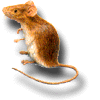[vc_row full_width=”” parallax=”” parallax_image=””][vc_column width=”1/1″][vc_column_text]
The deer mouse is a small rodent that appears similar to the house mouse, but has relatively larger eyes. It gets its name due to their running and jumping ability. They can be identified by their darker back color, and light coloring on their abdomen and feet. They are also a known carrier of the Hantavirus.
[/vc_column_text][/vc_column][/vc_row][vc_row full_width=”” parallax=”” parallax_image=””][vc_column width=”1/1″][vc_column_text]
As a wild animal the house mouse mainly lives associated with humans, causing damage to crops and stored food. The house mouse has been domesticated as the pet or fancy mouse, and as the laboratory mouse which is one of the most important model organisms in biology and medicine. It is by far the most commonly used genetically altered laboratory mammal. House mice have an adult body length (nose to base of tail) of 7.5–10 cm (3.0–3.9 in) and a tail length of 5–10 cm (2.0–3.9 in). The weight is typically 10–25 g (0.4–0.9 oz). They vary in colour from white to grey, and light brown to black. They have short hair and a light belly.
[/vc_column_text][/vc_column][/vc_row][vc_row full_width=”” parallax=”” parallax_image=””][vc_column width=”1/1″][vc_column_text]
Also known as the brown rat or sewer rat, the Norway rat is one of the best known and most common rats. The Norway rat is a brown or grey rodent with a body up to 25 cm (10 in) long, and a similar tail length; the male weighs on average 350 g (12 oz) and the female 250 g (9 oz). Thought to have originated in northern China, this rodent has now spread to all continents, except Antarctica, and is the dominant rat in Europe and much of North America—making it the most successful mammal on the planet after humans.Indeed, with rare exceptions the brown rat lives wherever humans live, particularly in urban areas.
[/vc_column_text][/vc_column][/vc_row][vc_row full_width=”” parallax=”” parallax_image=””][vc_column width=”1/1″][vc_column_text]
Also known as the black rat, the roof rat is usually black to light brown in colour with a lighter underside. A typical adult black rat is 12.75–18.25 in (32.4–46.4 cm) long, including a 6.5–10 in (17–25 cm) tail, and weighs 4–12 oz (110–340 g). It is nocturnal and omnivorous, with a preference for grains and fruit. Compared to the brown rat, it is a poor swimmer, but more agile and a better climber, tending even to flee upwards.
[/vc_column_text][/vc_column][/vc_row][vc_row full_width=”” parallax=”” parallax_image=””][vc_column width=”1/1″][vc_column_text]
Pack rats are a nest building rodent common in the northwest region of North America. Packrats have a rat-like appearance, with long tails, large ears and large black eyes. Packrats vary in size from species to species. Adult bushy-tailed woodrat males usually weigh 300-600 grams with an average of 405 grams, whereas adult females usually weigh only 250-350 grams with an average of 270 grams.
[/vc_column_text][/vc_column][/vc_row][vc_row full_width=”” parallax=”” parallax_image=””][vc_column width=”1/1″][vc_column_text]
White- Footed Mouse
The white-footed mouse is a rodent native to North America. It ranges from Canada to the southwest USA and Mexico. It is also known as the woodmouse.
Adults are 90–100 millimetres (3.5–3.9 in) in length, not counting the tail, which can add another 63–97 millimetres (2.5–3.8 in). A young adult weighs 20–30 grams (0.7–1.1 oz). While their maximum life span is 96 months, the mean life expectancy for the species is 45.5 months for females and 47.5 for males. In northern climates the average life expectancy is 12–24 months.
This species is similar to the Deer Mouse. Like the deer mouse, it may carry hantaviruses which cause severe illness in humans.
[/vc_column_text][/vc_column][/vc_row][vc_row full_width=”” parallax=”” parallax_image=””][vc_column width=”1/1″][vc_column_text]
A vole is an small rodent resembling a mouse but with a stouter body, a shorter hairy tail, a slightly rounder head, smaller ears and eyes. Voles are small rodents that grow to 3-9 inches, depending on the species. They can have 5–10 litters per year. Voles are commonly mistaken for other small animals. Moles, gophers, mice, rats and even shrews have similar characteristics and behavioral tendencies. Since voles will commonly use burrows with many exit holes, they can be mistaken for gophers or some kind of ground squirrel. In fact, voles are unique and best described as being a little bit like all the other animals they are so commonly thought to be.
[/vc_column_text][/vc_column][/vc_row]







